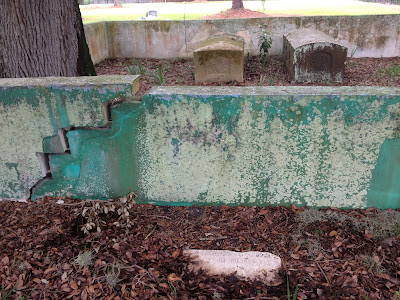After organizing my data and crunching numbers, the results are finally in! It turns out that the historic African-American cemeteries sampled in my project are in greater disrepair
than the historic White cemeteries.
In regards to marker type, White cemeteries were split down the middle, using both upright and flat markers equally. These markers were mostly made of granite, marble and zinc. However, 65% of the total African American graves surveyed were false vaults. For those of you that are unfamiliar with this term, false vaults are a type of burial where the coffin is placed in a shaft below the primary hole in the ground and then a concrete, coffin-like structure is built over it. This practice dates back to the early 1600's and can be found throughout the African continent. Because of this, the African-American cemeteries had a much higher percentage of concrete grave markers. Concrete was a cheap alternative to costly marker materials and was much more readily available to African-Americans in the past due to differing socioeconomic levels between African-American and White communities in the post-bellum south. Unfortunately, concrete has a tendency to deteriorate at a much faster pace than other marker materials and that's why we see such a difference in the conditions of grave markers between historic White and African American cemeteries.
In regards to marker type, White cemeteries were split down the middle, using both upright and flat markers equally. These markers were mostly made of granite, marble and zinc. However, 65% of the total African American graves surveyed were false vaults. For those of you that are unfamiliar with this term, false vaults are a type of burial where the coffin is placed in a shaft below the primary hole in the ground and then a concrete, coffin-like structure is built over it. This practice dates back to the early 1600's and can be found throughout the African continent. Because of this, the African-American cemeteries had a much higher percentage of concrete grave markers. Concrete was a cheap alternative to costly marker materials and was much more readily available to African-Americans in the past due to differing socioeconomic levels between African-American and White communities in the post-bellum south. Unfortunately, concrete has a tendency to deteriorate at a much faster pace than other marker materials and that's why we see such a difference in the conditions of grave markers between historic White and African American cemeteries.
Although marble markers were
evident in all of the African-American cemeteries sampled, they were typically
government issued headstones; belonging to veterans and provided at no cost to
the family of the deceased.
Zinc is extremely scarce in
African American cemeteries. This study
recorded only one instance of zinc usage in an African-American cemetery. Zinc markers were produced between the
mid-1870s and 1912 and were quite expensive due to their anti-corrosive
properties as well as the cost associated with their shipment from Connecticut
where they were produced.
Another issue among the African-American cemeteries
is the frequent use of temporary aluminum markers in the place of a sturdy,
permanent marker. Aluminum markers are known to corrode quickly and can be
easily moved. This would then result in an unmarked grave.
All cemeteries in general are threatened by inevitable, naturally occurring problems such as biological growth, erosion, weathering, and overgrown tree roots. Threats can also be caused by improper maintenance and vandalism. African-American cemeteries showed much more significant threats in place compared to White cemeteries. All four of the White cemeteries saw minor threats, while 75% of the African-American cemeteries saw major threats.
In conclusion, grave markers act as artifacts and tell a clear story of the inequalities African -Americans faced
even when it came to marking the grave of a loved one. Many simply could not
afford durable materials like zinc and granite, and instead opted for homemade
concrete markers which are less durable. My goal is to share this data with the community with hopes that it will encourage them to become more
involved in protecting these cemeteries and preserving their history. Protection of a threatened cemetery is not
just a human right that the deceased are entitled to, but it is also a way to
preserve significant cultural resources. Without proper maintenance, these
sites will fall into utter disrepair and irreplaceable knowledge of
African-American history will be lost.














































































